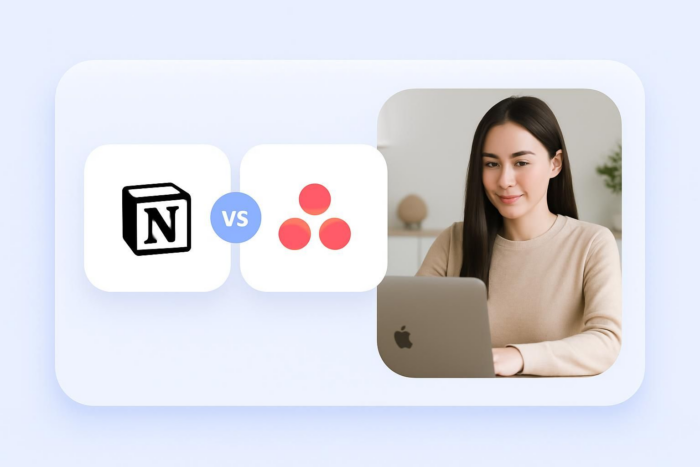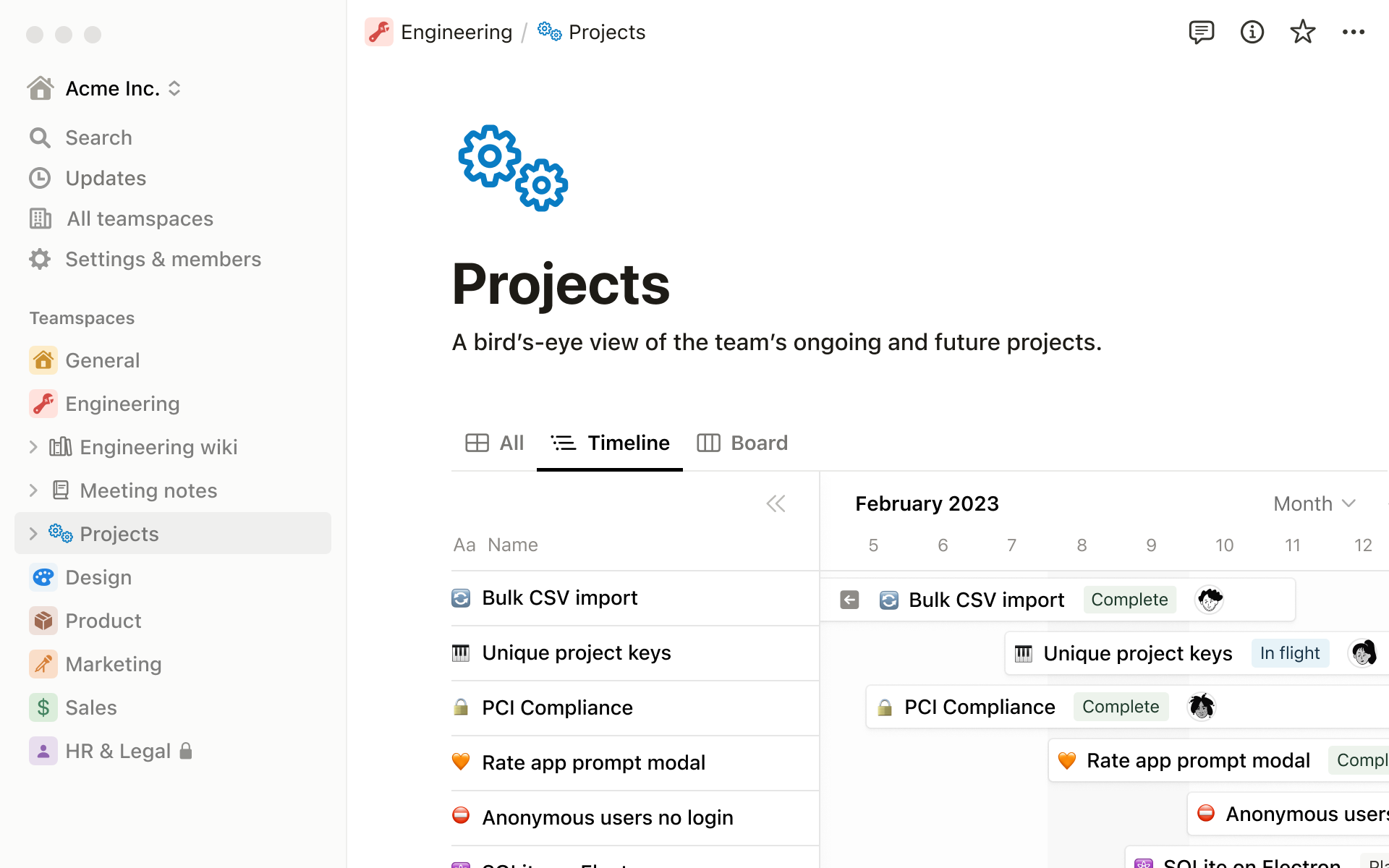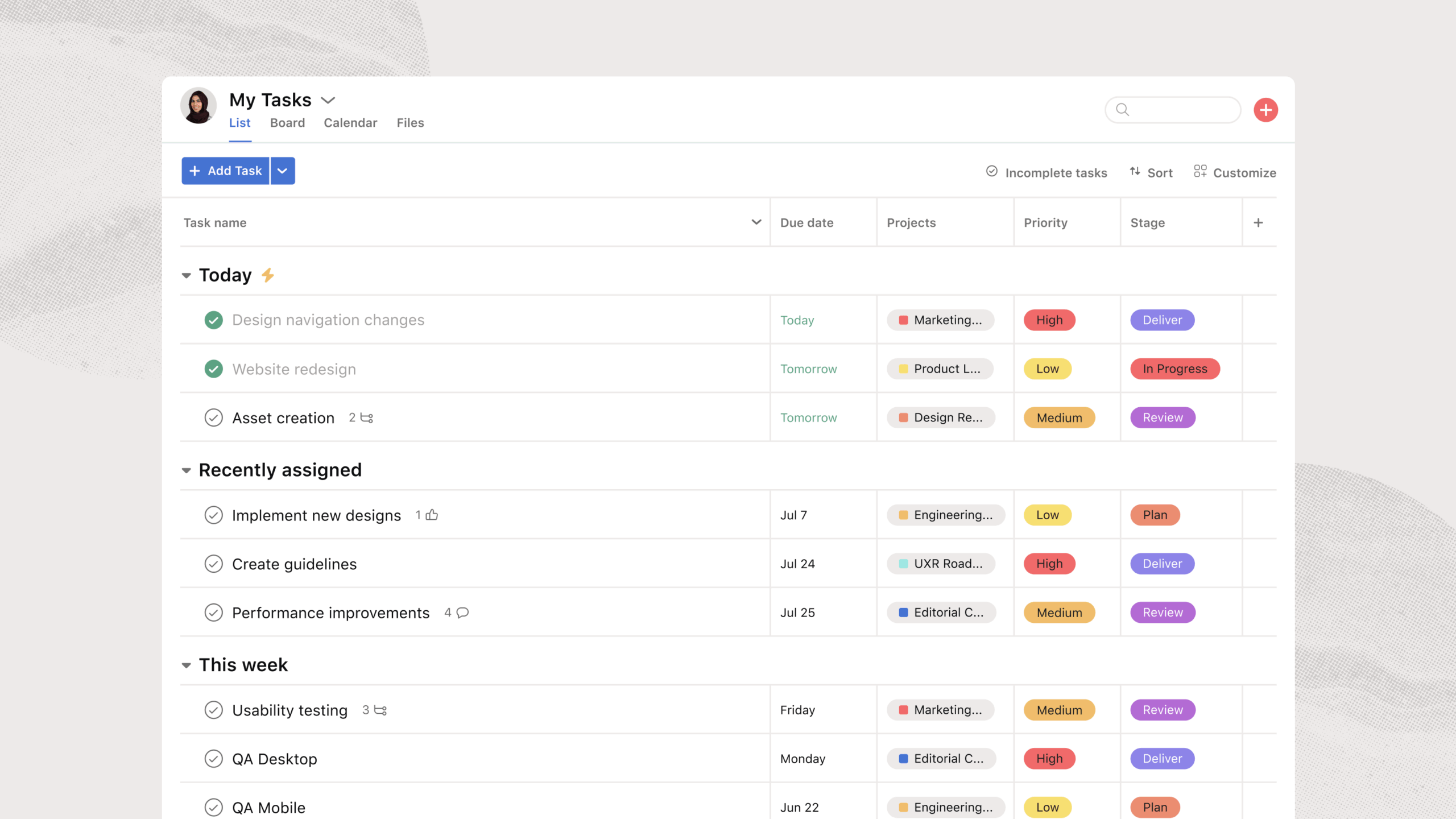4 key differences between Notion and Asana
If you’re on the hunt for a software product that can help your team execute projects seamlessly, you’ve likely seen the names of these two popular tools already: Notion and Asana.
As two of many in the project management and productivity space, they have been around for more than a decade and continue to attract new users. Have you been considering joining the ranks but don’t know which one to choose?
Notion and Asana both provide a platform to support teamwork and task completion. But they have some key differences.
Asana is a robust project management platform ideal for medium to large teams, while Notion is a more flexible work management tool, which may be more suitable for individuals and small teams.
Keep reading to learn more about Notion vs Asana so you can make an informed decision on what is best for your company. You’ll also learn about Jotform Boards, a versatile task management tool that might be an even better fit for your business.
Key differences between Notion and Asana
Before diving into the details of Asana vs Notion, it’s helpful to view them from a high-level perspective.
Both solutions earn good reviews from large numbers of users, but that doesn’t mean they’re a good fit for everyone. Your personal success with either depends on whether you’ve chosen the tool that addresses your company’s needs and aligns well with your team’s tech skills. (Note that Asana is also often compared to Trello; you can read about Asana vs Trello here.)
Here are some fundamental differences that stand out in a Notion vs Asana comparison:
Project management vs knowledge management
Asana is task-focused while Notion offers a more flexible, database-driven approach.
So that means that Asana is great for tracking and reporting on the progress of projects, as well as managing large-group tasks. In other words, its focus is on project management.
Notion also has some excellent project management features. However, it might be better described as a knowledge management tool because it also gives teams (or individuals) a centralized space to manage information, whether it relates to specific clients, projects, or other categories. Its powerful database features make it a strong choice for storing, managing, and analyzing project-related data.
Workflow collaboration vs content collaboration
Both tools support team collaboration but in different ways.
Asana’s collaboration tools center primarily around task progress and completion (and ultimately project completion). The platform allows team members to coordinate and schedule tasks, make to-do lists, discuss projects, and share project goals and milestones. It also offers a variety of ways to view project information, from Kanban boards and Gantt charts to calendars and timelines.
Notion has similar project management features that enable groups to keep activities moving and transparent. But it also supports collaboration on a broader scale, allowing teams, and even clients, to work together on documents, wikis, notes, and more. For instance, it supports real-time editing and version control features.
In short, Notion works well for collaborating on all types of information, project-related or not.
Different learning curves
Most people can learn how to use Asana quickly, especially if they’ve used other task management software products in the past.
Part of this intuitiveness is thanks to good design on Asana’s part, but it’s also a result of the straightforward scope of the platform, moving projects from point A to point B. Some of its advanced features may take more time to learn, but overall, Asana is the better choice if simplicity and a quick ramp-up are among your goals.
Notion, on the other hand, has a steeper learning curve, in part because it can be used in so many different ways.
There isn’t one “right” way to use it; instead, users must familiarize themselves with its broad functionality and determine the best way to apply it to their work. This takes time (and patience), but is ultimately worth it if you need the flexibility.
Different levels of customization
Both project management apps offer some degree of customization, but Asana users can only do so within the limits of the software’s project-management system. For example, you can create personalized workflows that integrate with different tools, and change the views of your work and other project-related data.
In contrast, Notion offers nearly limitless customization options.
You can use it for different purposes, like taking notes, managing client work, creating social media workflows, and more. You can change the way your workspaces appear, such as switching the colors for branding or creating themed workspaces, and develop helpful automations. You can even change the structure of database pages to highlight certain information.
Now that you understand some of the basics of Asana vs Notion, let’s take a more detailed look at each.
Notion: Strengths, limitations, and best use cases
As you might’ve picked up by now, Notion is a powerful choice for individuals and teams looking for an all-in-one workspace. Let’s break down some of its strengths and weaknesses, as well as the best use cases for this software.
Notion is best for
- Knowledge management: It can serve as a centralized hub for all company knowledge, making information easily accessible and manageable for everyone.
- Personal productivity: It supports individual productivity with features like to-do-lists, time tracking, goal tracking, and vision boards.
- Flexible workflows: Its versatility means you can create your ideal workflows to serve nearly any purpose, together with most other tools.
Developer: Notion Labs
Limitations: Notion’s vast flexibility can make it overwhelming for new users. The platform also lacks native advanced project management tools, which may prompt some to look for Notion alternatives that are stronger in this area.
Key features
- Custom databases: You can determine the structure and appearance of any database, allowing you to focus on the information you need.
- Document collaboration: Teams can work asynchronously or simultaneously on documents, commenting, tagging, and suggesting edits.
- Rich media embedding: You can easily embed anything into Notion, from videos and forms to maps and PDFs.
- Integrations: Notion connects with more than 140 other business tools (including Asana) for seamless workflows. Among the best Notion integrations are Slack, Zoom, Calendly, Box, and OneDrive.
Pros/cons
- Pros: Users love its wide-ranging versatility and the ability to customize workflows and view data in a variety of ways.
- Cons: First-time users find it difficult to learn the software and say there are few resources available to help. Some also mention feeling overwhelmed by the open-endedness of the platform.
Plans/pricing: Notion has a free plan appropriate for personal use; it also offers three paid plans starting at $10 per user, per month. It offers AI functionality for an additional $8 per user, per month.
G2 rating: 4.6/5
Asana: Strengths, limitations, and best use cases
Asana takes a more structured approach to project and task management, making it a preferred choice for teams handling complex projects.
Asana is best for
- Task management: You can create tasks and subtasks, assign responsibilities, and identify obstacles to help keep work moving.
- Team collaboration: Teams can discuss projects, collect approvals, give feedback, and view messages and announcements about ongoing work.
- Structured workflows: Asana supports traditional workflows that include planning, execution, and review of projects, helping to maintain consistency and clarity. It also includes workflow automation features.
Developer: Asana, Inc.
Limitations: While Asana offers some degree of flexibility within its project management framework, it is not flexible enough to be used for non-task related needs, such as project documentation and knowledge management.
Key features
- Task assignments: Asana allows for one task assignee and multiple collaborators, and all can be given access to view and make edits. Everyone receives update notifications.
- Project tracking: You can sort tasks by assignees, due dates, and priority so you can quickly assess progress on important tasks. You can also opt to get email updates about projects you’re involved in.
- Workflow automation: You can create custom workflows, both within Asana and across tools (like Slack or OneDrive), with no coding required.
- Reporting tools: Asana has a range of customizable dashboards that update automatically and are easily shareable.
Pros/cons
- Pros: Users love Asana’s strong collaboration features and large integration library.
- Cons: Some users feel Asana isn’t worth the price compared to other, similar platforms.
Plans/pricing: Asana offers a free plan suitable for individuals and small teams; it also has two paid options starting at $10.99 per user, per month for an annual plan (or $13.49 for a monthly subscription). Contact Asana for enterprise pricing information.
G2 rating: 4.4/5
Notion vs Asana: Feature-by-feature comparison
 Notion | Asana | |
|---|---|---|
| Best suited for … | Engineering teams, creative teams, teams needing knowledge bases for idea development and execution | Remote teams, product development teams, large enterprises needing structured project management |
| Task and project management capabilities | Project organization: Flexible project views, both structured and unstructured Task management: Flexible but basic task management features Reporting/dashboards: Includes dashboard templates for manual creation | Project organization: Variety of traditional but structured project management views Task management: Advanced capabilities, including assignees, customizable fields, dependencies, and more Reporting/dashboards: Includes real-time, robust dashboards that include progress tracking |
| Collaboration tools | Editing: Full page/database editing File sharing: Can upload docs directly within Notion pages and databases Communication: Can leave and respond to comments, create discussion pages, and give updates Collaborative workspace: Workspaces for viewing and editing projects and databases | Editing: Comments on tasks only File sharing: Can only link to files stored within cloud platforms (Google Drive, Dropbox, etc.) Communication: Can make comments on tasks, send messages, and give status updates Collaborative workspace: Workspaces only for access to project tasks |
| Customization and flexibility | Templates: 30,000+ on everything from project plans to notes to calendars and more Versatility: Can replace a variety of other tools Customization: Nearly unlimited customization options for many use cases | Templates: Dozens, all focused on project management Versatility: Project management tool only Customization: Standard customizations to project views, workspace aesthetic, and tasks |
| Ease of use and learning curve | Learning curve: Takes time to learn Help available: Offers an introductory video series and a variety of user guides | Learning curve: Easy to learn with the exception of advanced features Help available: Offers on-demand courses and webinars, live trainings, and more |
| Integrations and automation options | Integrations: 100+ Automation: Native and third-party automations available; you can also code your own | Integrations: 200+ Automation: Native and third-party automations available; you can also code your own |
| Pricing and value for money | Free plan: Yes Price options: 3 available, including $10 per seat, per month, $15/seat, per month, and an enterprise plan. Access AI features for an additional $8 per member per month Free trial: Yes | Free plan: Yes Price options: 3 available, including $10.99 per user, per month (billed annually), $24.99 per user, per month, and an enterprise plan. Free trial: Yes |
| Try It Now | Learn More |
Bottom line: Asana shines as a fairly simple, structured project management tool, though its use is strictly limited to managing projects and tasks in the traditional sense.
Notion stands out for its versatility and has a number of different use cases, including project management. But Notion users sacrifice more advanced project management features and ease of use for the sake of this flexibility.
Your choice depends on your needs. Keep reading to find out about another option that’s both easy to use and flexible, and might be the perfect fit for your company.
Jotform Boards: A flexible alternative
Interested in exploring other options besides Notion and Asana? Jotform Boards is another task management tool that helps you manage your operations in one centralized place.
Like the best project management tools, it has advanced task organization and collaboration settings and is incredibly easy to use. But it can also automatically create tasks from any form-based processes or other communication channels used in your business!
For example, if you use forms to collect customer orders online, you can link those order forms to Jotform Boards. Every time an order is submitted, a new task will automatically appear on the board. This direct link between forms and your task board makes workflows seamless, and your life easier.
Jotform Boards is an excellent alternative to both Notion and Asana. You can
- Automatically create tasks from multiple sources. In addition to the example above showing task creation from form submissions, you can also automate new tasks that arise through AI agent conversations and workflows. (And you can also create tasks manually if you like.)
- Connect your forms to boards. Connect any of your company’s forms to your board(s) to automatically create actionable tasks quickly and easily. Nothing will fall through the cracks again!
- Take advantage of AI-powered automation. AI Agents can create tasks based on customer orders, inquiries, or applications. So if, for example, a customer tells your website’s AI agent that they have a need for tech support, a new task will automatically be created based on that conversation.
- Encourage a seamless workflow. You can automate task creation as workflows progress, keeping your processes smooth and organized. You can even connect multiple workflows to a single board, or multiple boards to a single workflow.
- Get rolling fast! Jotform Boards uses a familiar Kanban-style board with drag-and-drop functionality, making it an intuitive, easy-to-use platform that you and your team will pick up quickly. Plus, we have lots of templates to help you get started.
Intrigued? Give Jotform Boards a try for free today. It might be just the productivity and project management solution you’ve been looking for!
This article is for team leaders, project managers, small business owners, and individual professionals who are trying to decide between Notion and Asana for managing tasks, projects, and collaboration. It’s designed to help readers understand the strengths and limitations of each tool so they can choose the platform that best fits their workflow.























Send Comment: